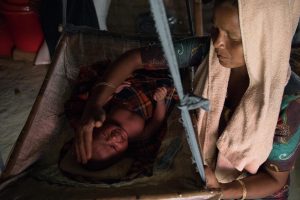
Rohingya mother Hala*, 35, sits with 25 day-old baby Rama* in her makeshift tent in Cox's Bazar, Bangladesh. In her own words: “They burned our houses leaving none. My house and everything inside was burnt. My cattle were taken away” “We walked for three days. I was worried my baby would be born on the way. We reached the border on the fourth day. We crossed on the fifth day. We had no food and no sip of water. We couldn’t walk any further. Our legs swelled.” “We came here to save our lives.” “After crossing we received food. After eating we felt stronger but we couldn’t get up. Our children were sick.” ‘On the sixth day, we found the clinic and built our tent.” “It was the eighth month of the pregnancy and the pains started. We went to the clinic where the child was delivered.” ‘The doctors gave us nice care and treatment. They also treated my two children who fell ill because of the journey.” “They come and check the baby weekly. Two weeks from birth, the baby got pneumonia. We had no blanket and the baby was cold. I was scared the baby would die. The nurses saw my baby and gave treatment. We are both fully recovered.” “I am breast-feeding. The baby can sleep and eat properly. I am now able to sleep properly. I feel very happy.” “I want my child to have an education.”
Background
Chlorhexidine (CHX) cleansing of the umbilical cord stump is an evidence-based intervention that reduces newborn infections and is recommended for high-mortality settings. Bangladesh is one of the first countries to adopt and scale up CHX nationally. This study evaluates the implementation outcomes for the CHX scale up in Bangladesh and identifies and describes key milestones and processes for the scale up.
Methods
We adapted the RE-AIM framework for this study, incorporating the WHO/ExpandNet model of Scale Up. Adoption and incorporation milestones were assessed through program documents and interviews with national stakeholders (n = 25). Provider training records served as a measure of reach. Implementation was assessed through a survey of readiness to provide CHX at public facilities (n = 4479) and routine data on the proportion of all live births at public facilities (n = 813 607) that received CHX from December 2016 to November 2017. Six rounds of a rolling household survey with recently-delivered women in four districts (n = 6000 to 8000 per round) measured the effectiveness and maintenance of the scale up in increasing population-level coverage of CHX in those districts.
Results
More than 80 000 providers, supervisors, and managers across all 64 districts received a half-day training on CHX and essential newborn care between July 2015 and September 2016. Seventy-four percent of facilities had at least 70% of maternal and newborn health providers with CHX training, while only 46% had CHX in stock on the day of the assessment. The provision of CHX to newborns delivered at facilities steadily increased from 15 059 newborns (24%) in December 2016 to 71 704 (72%) in November 2017. In the final household survey of four districts, 33% of newborns were reported to receive CHX, and babies delivered at public facilities had 5.04 times greater odds (95% CI = 4.45, 5.72) of receiving CHX than those delivered at home.
Conclusions
The scale up of CHX in Bangladesh achieved sustained national implementation in public health facilities. Institutionalization barriers, such as changes to supply logistics systems, had to be addressed before expansion was achieved. For greater public health impact, implementation must reach deliveries that take place at home and in the private sector.